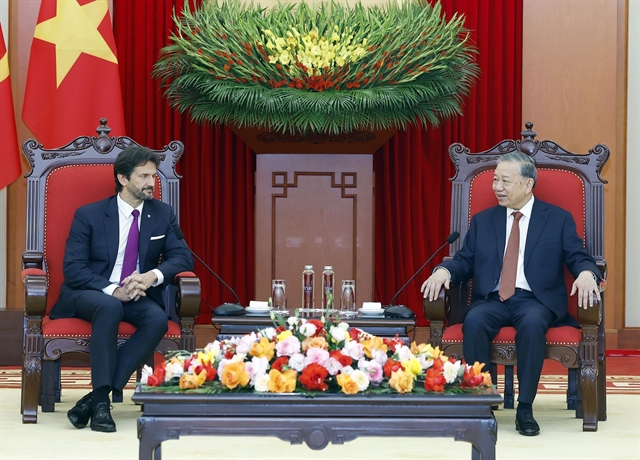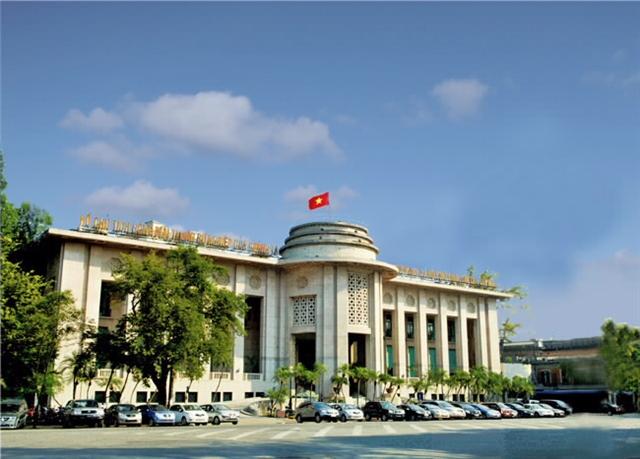 Business Beat
Business Beat

 |
| Headquarters of the State Bank of Vietnam (SBV). The SBV last month issued more than VNĐ110 trillion of 28-day bills and KBSV’s analysts don’t rule out the possibility that the SBV can even increase the size and term of issued bills. Photo sbv.gov.vn |
HÀ NỘI — The State Bank of Vietnam (SBV) will continually issue new bills to withdraw cash from the banking system in the context that liquidity is abundant and interbank interest rates remain low, analysts forecast.
The SBV last month issued more than VNĐ110 trillion of 28-day bills, and the bills will mature this month. As a result, a corresponding amount of cash will be pumped back into the banking system if the SBV does not issue new bills. However, given that interbank interest rates are still low, KB Vietnam Securities Joint Stock Company (KBSV)’s analysts believe the SBV will continue to issue new bills to replace those that are maturing.
They explained that the move will be made as the overnight interbank interest rate returns to very low levels while the interbank foreign exchange rate and the interest rate gap between US dollar-denominated deposits and Vietnamese đồng-denominated deposits remain high. This will stimulate dollar speculation and put pressure on the foreign exchange rate.
KBSV’s analysts do not rule out the possibility that the SBV might even increase the size and term of bills to be issued in the coming time.
In fact, in recent sessions, the SBV has moved to increase cash withdrawal through bill issuance. In the first nine trading sessions in early October, the SBV issued bills worth less than VNĐ10 trillion each, but from October 12, 2023, to October 16, 2023, the SBV increased it to VNĐ20 trillion each. Even on October 17, 2023, the bill value reached VNĐ17.95 trillion and VNĐ12.05 trillion the following day.
In the latest five trading sessions, the SBV withdrew VNĐ90 trillion, marking the strongest net withdrawal series since the bill issuance channel resumed operations on September 21. At the same time, the winning interest rate also remained at a high level of 0.9-1 per cent, indicating a more aggressive stance from the SBV in withdrawing cash.
Three scenarios
KBSV’s analysts have outlined three scenarios for the SBV’s bill issue, corresponding to different foreign exchange rate zones.
According to the first scenario, if the foreign exchange rate remains stable at around VNĐ24,000 to VNĐ24,400 per US dollar, the SBV will likely issue an average volume of bills worth about VNĐ12 trillion per session.
In the event the exchange rate surpasses the threshold of VNĐ24,500 per dollar, the SBV will issue an average volume of VNĐ20 trillion per session until the exchange rate displays clearer signs of stabilisation.
In the third scenario, should the dollar exchange rate near the VNĐ25,000 mark, KBSV does not dismiss the possibility that the SBV will opt to sell the dollar forward to stabilise the exchange rate.
Dr. Trần Ngọc Thơ from HCM City University of Economics suggests that to circumvent the cycle of withdrawing money every 28 days and then reinjecting it, which might create negative market sentiment, the SBV could issue bills with longer terms, either monthly or annually.
However, the issuance of long-term bills requires stringent regulations and collaboration between the Ministry of Finance (MoF) and the SBV, as the MoF’s State Treasury also issues bills.
The SBV recommenced the money withdrawal channel via bill issue on September 21 this year after over six months of hiatus. With 20 consecutive sessions of issuing bills, the SBV has extracted nearly VNĐ255.7 trillion from the banking system.
Explaining the rationale behind resuming the bill issuance channel, SBV’s deputy governor, Phạm Thanh Hà, highlighted that recently, the SBV has had to issue short-term bills to diminish excess liquidity in the banking system. This strategy aims to limit significant disruptions to the interest rate level. Presently, interest rates in the interbank market remain steady, but there will be substantial pressure in the foreseeable future as Việt Nam endeavours to harmonise interest and foreign exchange rates.
According to Hà, the SBV is vigilantly observing the foreign currency market and striving to maintain a stable exchange rate. Nevertheless, Hà acknowledged the intricacy of the SBV's task, given the intricate relationship between interest rates and foreign exchange rates.
Concurrently, after a minor dip earlier this month, the dollar exchange rate in the banking market has made a comeback, currently trading at its zenith since the start of the year. On October 19, the dollar rate at commercial banks saw a significant surge, notably exceeding the VNĐ24,700 threshold. Specifically, Vietcombank – the institution with the most substantial foreign currency transactions in the banking system – set the dollar buying and selling rates at VNĐ24,370 and VNĐ24,740, respectively, a rise of VNĐ125 compared to the prior weekend.
Thus, from early October to the present day, the dollar exchange rate at commercial banks has ascended by roughly VNĐ280, equivalent to a surge of over 1.1 per cent. The rate has, to this point in the year, climbed by VNĐ1,000, or in excess of 4.2 per cent.
Given the possibility that the US Federal Reserve (Fed) might further elevate interest rates towards the year's end, these exchange rate trends are exerting definite pressure on the SBV's administrative duties, including open market operations (OMO). — VNS




